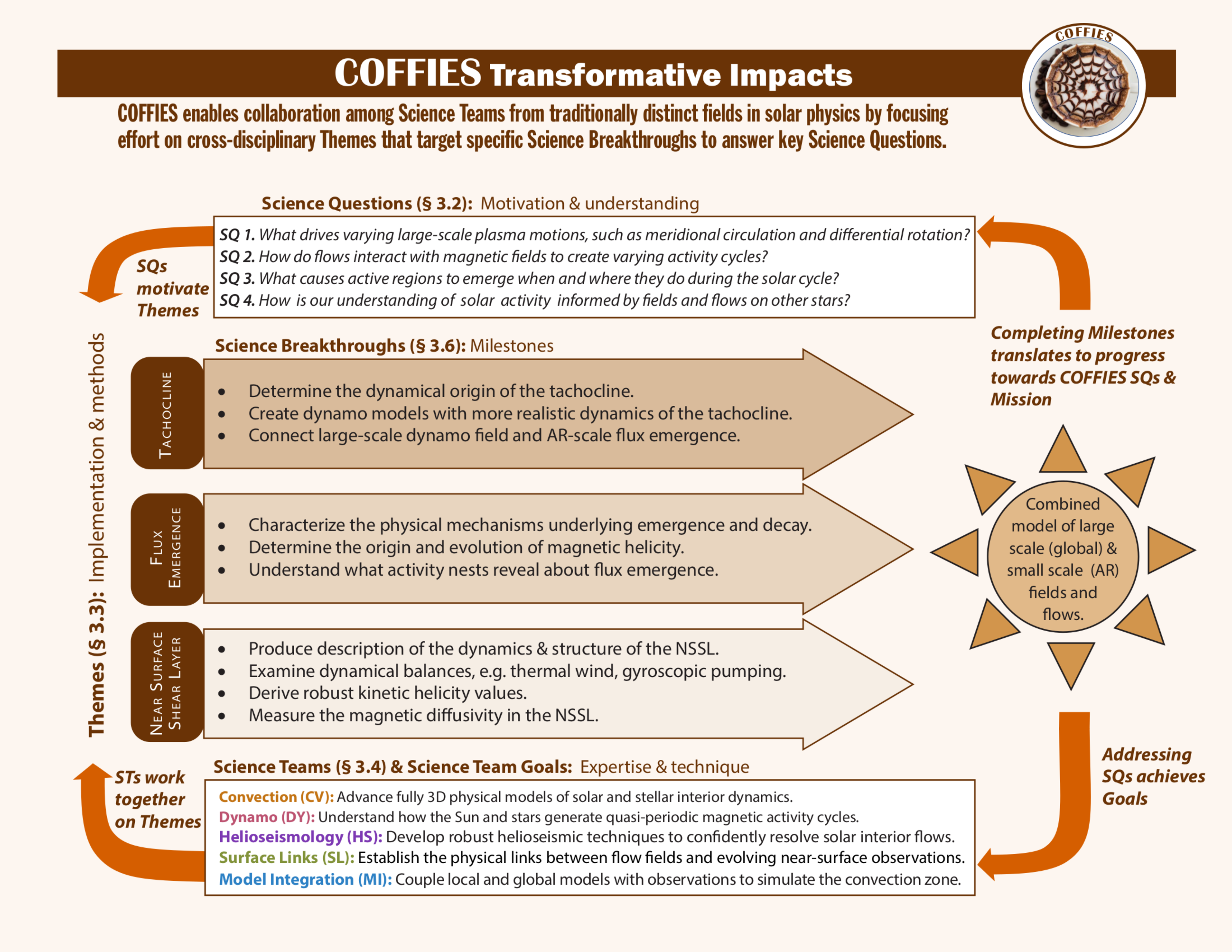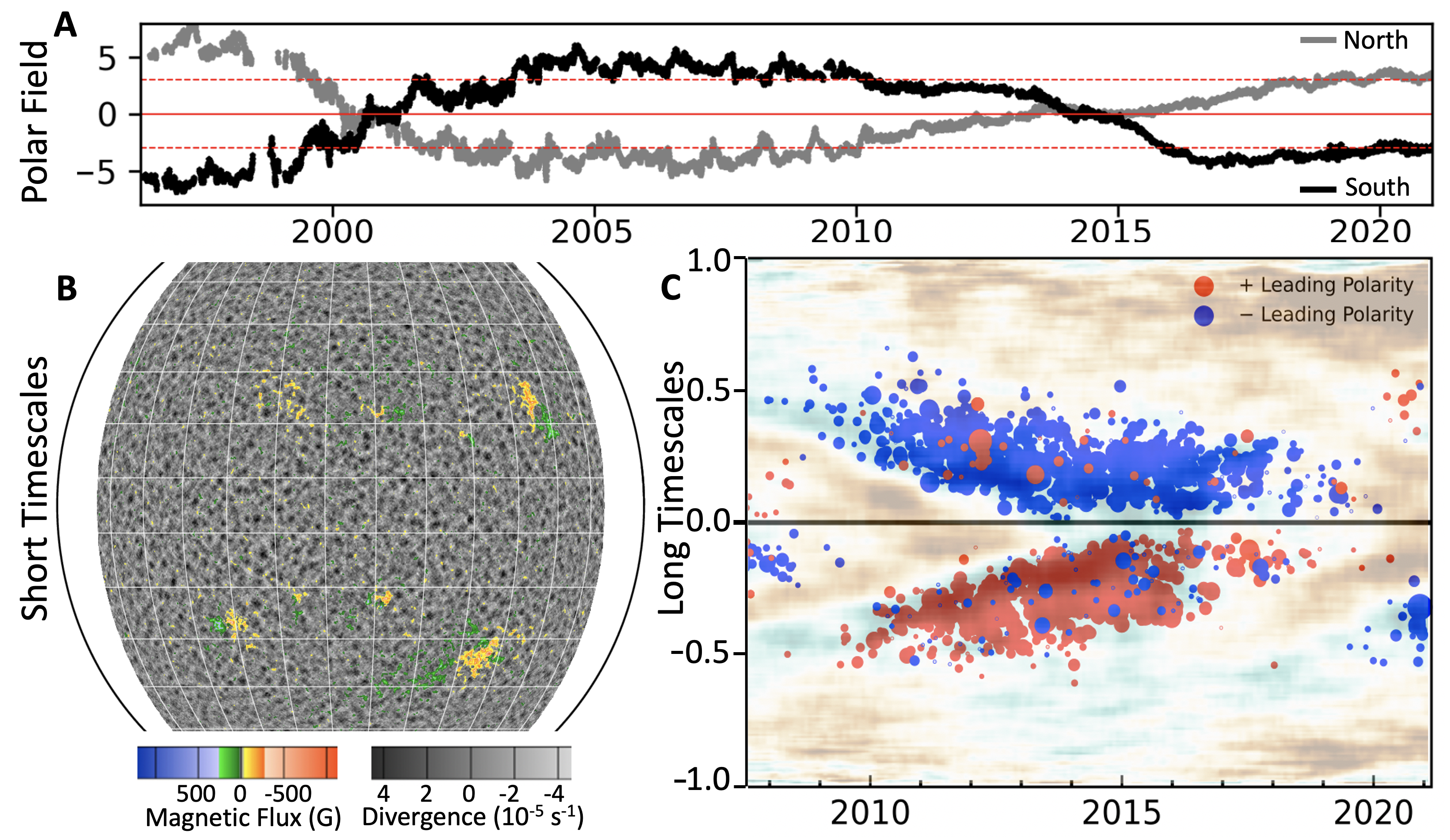Welcome to COFFIES!
COFFIES is one of three NASA-funded Heliophysics Phase II DRIVE (Diversify, Realize, Integrate, Venture, Educate) Science Centers (DSC), working to establish a multi-institution collaboration to develop the most reliable data driven physical model of solar activity possible.

Vision
Expand understanding of the Sun to develop the capability to forecast activity cycles and magnetic field variability by creating a center of excellence in Solar Physics that fosters a broad range of perspectives and expertise.
Mission
COFFIES establishes a collaborative science community that will develop comprehensive models of solar dynamics and, using high-fidelity helioseismic and photospheric measurements of flows and fields as constraints, substantially improve physical understanding of the ways internal plasma flows affect the origin and evolution of magnetic activity cycles of the Sun and stars like it.
Motivation
Solar and stellar dynamos stem from the complex interaction of the magnetic field with small- and large-scale flows within their interiors. A Consequence Of Fields and Flows in the Interior and Exterior of the Sun (COFFIES) is the roughly 11-year quasi-periodic magnetic activity cycle. This varying magnetic field drives space weather and the dynamic environment in which the Earth resides, and therefore an understanding of this variability, leading ultimately to reliable forecasts, is of paramount importance. Yet despite improved observations and years of theoretical modeling efforts, it is still not well understood how the Sun generates, replenishes, and maintains the magnetic field that creates the observed characteristics of the solar cycle (SC; Charbonneau, 2014), i.e., how the Sun’s dynamo operates. Our Center aims to transform this understanding, cited as the first science challenge posed in the 2013 Decadal Survey.

Figure 1: COFFIES Transformative Impacts. This figure illustrates the relationship between the SQs, Themes, and Teams and how we will eliminate traditional boundaries to make Science Breakthroughs.
To achieve transformational scientific breakthroughs (Fig. 1), we must first address why understanding stars like the Sun is so difficult. The most challenging issue is the tremendous range of dynamical scales. Due to a star’s strong nuclear forcing, immense size, and the extremely low diffusivity of gases involved, dynamical processes operate on scales from the stellar radius (∼700 Mm for the Sun) to the diffusive scale (∼ cm). We observe the Sun at many of these scales (down to tens of kms). For example, global helioseismology provides the rotational profile spanning the majority of the deep interior, whereas local helioseismology provides information about motions around sunspots. We also observe small magnetic elements within granular lanes at the surface as well as narrow filaments spanning large sections of the star in the solar atmosphere. Despite the enormous range of scales, coherent characteristics of the observed magnetic cycle emerge, e.g., the magnetic butterfly diagram (Fig. 2), Hale’s Law for polarity, and Joy’s Law for tilt.

Figure 2: Measured fields and flows for various timescales used by COFFIES. Panel A) strength of the solar polar fields (Gauss) since 1996; B) horizontal flow divergence showing supergranules (grayscale) and magnetic field for 2021.09.27; and C) butterfly diagram for SC~24 showing active regions in time vs.~sin(latitude); leading spot polarity is shown in red (blue) and flux by marker size; background brown (green) shows variations in azimuthal flows, i.e., torsional oscillations.
Despite the fact that the basic equations of the dynamics are reasonably well known, no class of theoretical or numerical modeling can cope with this wide range of dynamical scales. The traditional approach has been to concentrate on a limited range of scales. For example, the majority of our intuition on the operation of such dynamos is built from mean field electrodynamics (MFED). MFED concentrates on modeling the very largest scales of the magnetic field, and has been able to reproduce the characteristics of the Sun’s large-scale flows and cyclic fields reasonably well. However, the modified equations that single out the largest scales must necessarily approximate the smaller-scale turbulent motions, and how to do this realistically is a complex problem. As another example, local models of magnetic flux emerging into the photosphere can replicate the characteristics of active regions, but no dynamical connection exists between the initial conditions of these models and the large-scale dynamo field that must be their ultimate source. This scale issue has essentially forced researchers into specialist areas that can be associated with certain scales or particular sub-regions of the star. Proceeding beyond our current understanding and confronting the whole problem requires cross-cutting connections among traditional elements.